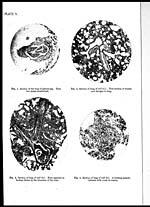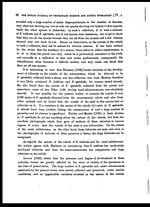Medicine - Veterinary > Veterinary colleges and laboratories > Indian journal of veterinary science and animal husbandry > Volume 4, 1934 > Original articles > Comparative study of Schistosoma spindalis, Montgomery, 1906 and Schistosoma nasalis, N. Sp.
(33) Page 21
Download files
Individual page:
Thumbnail gallery: Grid view | List view

SCHISTOSOMA SPINDALIS, MONTGOMERY, 1906, & SCHISTOSOMA NASALIS, N. SP. 21
Such pathological changes, due to the toxic effects of only male schistosomes,
have been recorded in man and animals by Fairley [1924 and 1926]„ Fairley and
Williams [1927], Faust [1927], Girges [1929], and Fairley and Mackie [1930].
The selection of the respiratory system by the nasal schistosome and the portal
system by S. spindalis, even when reared in guinea-pigs, appears to be of some
significance. Fairley, Mackie and Jesudasan [1930], found that when guinea-
pigs were infected with S. spindalis the worms were confined to the portal system.
The author's findings confirm this. Brumpt and Chevallier [1931], infected some
mice with cercariae of S. mansoni and a few others with S. haematobium and found
that in the latter the lungs were usually affected in addition to the liver, whereas in
the former the reverse was the case. This supports the view that the nasal
schistosome resembles S. haematobium in its behaviour in selecting its habitat.
DISCUSSION ON SOME POINTS OF DIFFERENCE IN THE MORPHOLOGY OF
S. SPINDALIS AND THE NASAL SCHISTOSOME .
(a) Size :—It has been admitted that the average size of schistosomes may
vary with the age of the parasite, mode of preservation, time of collection
after the death of the host, etc., but still the question remains whether or not
there is difference in size between the different species. From the dimensions
given in the text books for various species, it is agreed that different species have
different sizes—a character which is useful when considered along with other
morphological details. The dimensions of the nasal schistosome have been re-
corded by Bhalerao [1932] and Rao [1932] and from these it is gathered that this
species is smaller than S. spindalis Montgomery 1906. Bhalerao, however, believes
that the nasal schistosome fails to reach the maximum size attained by other
schistosomes, because the former grows in a tough tissue like the nasal septum
and does not get the same scope for development as those growing in the portal
or mesenteric veins. This explanation seems to be untenable because the different
species of schistosomes developing in the portal system of man and animals
differ in their average sizes, even though they all have equal scope for develop-
ment there. It has been shown above that the nasal schistosomes live in the
veins of tissue, which resembles cavernous tissue, having several strata of freely
anastomosing veins and in such tissue they necessarily get as much scope for
development as the others have in the portal system. It would seem therefore
that the site of infection has no bearing on the variation in size met with, apart
from the character of the species.
(b) Nature of the cuticle:—It has been said above (p. 19) that sheep
harbour both S. spindalis and S. indicum at the same time and that only the
latter showed moderately developed tubercles on its cuticle. An examination of
the collection of schistosomes that exists in the Madras Veterinary College Museum
Set display mode to: Large image | Zoom image | Transcription
Images and transcriptions on this page, including medium image downloads, may be used under the Creative Commons Attribution 4.0 International Licence unless otherwise stated. ![]()
| Permanent URL | https://digital.nls.uk/75232142 |
|---|
| Description | Covers articles from 1934. |
|---|




